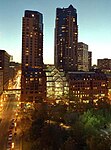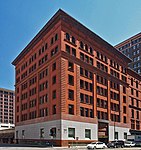Saint Paul Union Depot

Saint Paul Union Depot is a historic railroad station and intermodal transit hub in the Lowertown neighborhood of the city of Saint Paul, Minnesota, United States. It serves light rail, intercity rail, intercity bus, and local bus services. It is the eastern terminus for the METRO Green Line light rail line, with the stop located outside the station's headhouse. It is also the Twin Cities' stop for Amtrak, the national intercity railroad service. In addition to rail, Union Depot also serves Metro Transit, Minnesota Valley Transit Authority (MVTA), Jefferson Lines, Greyhound Lines, and Megabus. The headhouse, located at the 4th Street entrance, was designed by architect Charles Sumner Frost and is neoclassical in style. The concourse and the waiting room that extend over the tracks are viewed as a great architectural achievements. The building was added to the National Register of Historic Places in 1974. It is also a contributing property to the Lowertown Historic District.In addition to its transit uses, Union Depot also contains a Hertz rental car location, coffee shop, restaurant, a bike shop, offices, a museum, and loft condominiums.
Excerpt from the Wikipedia article Saint Paul Union Depot (License: CC BY-SA 3.0, Authors, Images).Saint Paul Union Depot
East Kellogg Boulevard, Saint Paul Downtown
Geographical coordinates (GPS) Address Phone number Website Nearby Places Show on map
Geographical coordinates (GPS)
| Latitude | Longitude |
|---|---|
| N 44.947777777778 ° | E -93.086111111111 ° |
Address
Union Depot
East Kellogg Boulevard 214
55101 Saint Paul, Downtown
Minnesota, United States
Open on Google Maps











